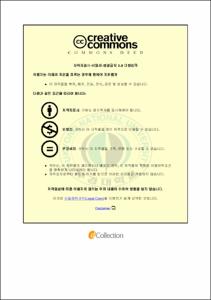개인 교통수단으로서 자동차와 자전거에 대한 생태효율성 평가
- Alternative Title
- Eco-efficiency evaluation for automobile and bicycle as a personal transportation
- Abstract
- 자동차와 자전거를 1km 운행하는데 필요한 면적은 자동차가 8.3E-04 m²/VKT, 자전거는 2.3E-04 m²/VKT으로 계산되었다. 이 결과를 토대로 재생가능에너지, 제조, 운행, 도로건설과 같은 4가지 항목으로 분석해 보면, 자동차와 자전거의 운행에 필요한 도로 건설의 에머지가 가장 높은 것으로 나타났다. 그러나 각 세부항목별로 보면 자동차는 도로 건설에 따른 재료의 비중이 가장 높았고 자전거는 자전거를 운전하는데 필요한 노동력이 가장 높았다. 도로를 제외하고 분석하면 자동차는 연료 소비가 가장 높게 나타났고 자전거는 자전거 운전을 위한 노동력이 매우 높게 나타났다.
결과적으로 단위거리 주행에 필요한 에머지는 자동차가 5.76E+12 sej/PKT로 나타났고 자전거는 2.02E+12 sej/PKT로 나타남에 따라 승객 1명을 태우고 1km를 가는데 생태 경제적으로 자전거가 더 효율적인 운송시스템으로 나타났다. 그러나 승객 무게나 차량 무게 등에 따라 비교해 보면 승객 1명씩 타고 운행할 때는 자전거가 더 효율적인 반면 승객 3명이상 또는 차량 무게나 화물의 무게를 고려한다면 자동차의 효율이 더 높은 것을 알 수 있었다.
또한 이동거리에 따라 요구되는 에머지량을 보면 자동차는 이동거리가 증가할수록 에머지값이 감소하는 반면 자전거는 증가하는 양상을 나타내었다. 따라서 처음에는 자전거의 필요 에머지값이 낮아 효율이 좋지만 약 18km를 기점으로 교차되면서 그 이후에는 자동차가 자전거 보다 더 효율적으로 나타났다. 결과적으로 18km 이전까지는 자전거를 이용하는 것이 더 효율성이 있는 반면, 그 이후는 자동차가 더 낫다는 것을 알 수 있었다.
Eco-efficiency of automobiles and bicycles as personal transportation alternatives in Korea was evaluated using the emergy methodology. All the data in the evaluation were expressed as the amount of emergy required to take a passenger or passengers for one kilometer travel(sej/PKT).
Areas required to travel 1 km distance by an automobile and a bicycle were calculated as 8.3E-04m²and 2.3E-04m2, respectively. Construction of roads or bicycle lanes accounted for the most emergy input for both transportation systems.
Except the construction emergy input, emergy in fuels for operation was the largest for the automobile system, while cyclist controls such as pedalling occupied the highest emergy input for the bicycle system. Emergy per unit travel distance was 5.76E+12 sej/PKT for the automobile system and 2.02E+12 sej/PKT for the bicycle system. Bicycles are, therefore, more efficient means of transportation than automobiles, with less emergy to move one passenger for 1km. Automobiles, however, were more efficient when there are more than 3 passengers to carry or the weight of a vehicle is included in the evaluation for the one passenger scenario.
Emergy required to move a passenger one kilometer decreased with the increase in the travel distance for automobiles, while that of bicycles increased with the distance. After 18km, the emergy requirement for bicycles exceeded that for automobiles. This means that bicycles are a more efficient way to move a passenger up to 18km, and automobiles for distances longer than 18km.
- Issued Date
- 2009
- Awarded Date
- 2009. 8
- Type
- Dissertation
- Publisher
- 부경대학교 대학원
- Affiliation
- 부경대학교 대학원
- Department
- 대학원 생태공학과
- Advisor
- 이석모
- Table Of Contents
- Ⅰ. 서론 = 1
Ⅱ. 연구배경 = 4
1. 자동차 및 자전거 이용 현황 = 4
가. 국내 자동차 및 자전거 이용 현황 = 4
나. 자동차 및 자전거 교통의 일반적 특성 = 6
다. 자전거의 이용적 특성 = 8
라. 자전거 교통의 효과 = 11
마. 자전거 이용의 제한 요인 = 12
2. 에머지 분석법 = 14
가. 시스템 생태학 = 14
나. 에머지 개념 = 15
3. 연구 사례 = 20
가. 자전거 활성화를 위한 연구 = 20
나. 교통수단에 대한 에머지 분석 연구 = 20
Ⅲ. 연구방법 = 21
1. 에머지 분석표 작성 = 21
가. 다이어그램 작성 = 21
나. 에머지 분석표 작성 = 22
2. 지표 분석 = 22
가. Emergy per passenger kilometer ratio = 23
나. Emergy per ton kilometer ratio = 24
다. Service to resource ratio = 24
라. Trip length efficiency = 24
Ⅳ. 결과 및 고찰 = 25
1. 자동차와 자전거의 에머지 분석 = 25
가. 운송수단의 다이어그램 작성 = 25
나. 총주행거리와 단위주행면적 산출 = 26
다. 자동차와 자전거의 에머지 분석 = 28
2. 자동차와 자전거의 에머지 지표분석 = 34
가. 주행거리당 에머지 = 34
나. 수송무게당 에머지 = 35
다. 자원에 대한 용역 비 = 36
라. 거리에 따른 생태효율성 평가 = 40
Ⅴ. 결론 = 42
참고문헌 = 43
Appendix A. Footnotes of emergy evaluation of automobile as a personal transportation = 47
Appendix B. Footnotes of emergy evaluation of bicycle as a personal transportation = 51
Acknowledgments = 54
- Degree
- Master
- Files in This Item:
-
-
Download
 개인 교통수단으로서 자동차와 자전거에 대한 생태효율성 평가.pdf
기타 데이터 / 1.01 MB / Adobe PDF
개인 교통수단으로서 자동차와 자전거에 대한 생태효율성 평가.pdf
기타 데이터 / 1.01 MB / Adobe PDF
-
Items in Repository are protected by copyright, with all rights reserved, unless otherwise indicated.